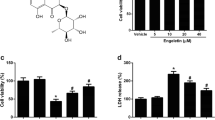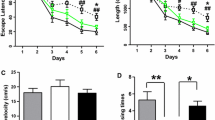Abstract
The NOD-like receptor family pyrin domain containing 3 (NLRP3) inflammasome activation-mediated microglial polarization and chronic neuroinflammation play a crucial role in the process of Alzheimer’s disease (AD). The previous study has shown that cattle encephalon glycoside and ignotin (CEGI) exerted an anti-inflammatory effect and inhibited inflammatory cytokines release by downregulating the Toll-like receptor 4 (TLR4)/nuclear factor kappa B (NF-κB) pathway in AD models. However, it is not clear whether CEGI can inhibit NLRP3 inflammasome activation and regulate the polarization of microglia in AD and whether its effects rely on TLR4/NF-κB signaling pathway. In the present study, we found that CEGI attenuated amyloid-β (Aβ)1–42-induced apoptosis, increased Aβ degrading enzymes (insulin-degrading enzyme and neprilysin), and promoted the clearance of Aβ1-42 in BV2 cells. CEGI also restrained the expression of NLRP3 and M1 microglial marker (inducible nitric oxide synthase) and elevated the expression of M2 microglial markers (arginase-1 and CD206). Meanwhile, knockdown of TLR4 with small interfering RNA proved that TLR4/NF-κB signaling was involved in the effects of CEGI. Furthermore, the roles of CEGI in inhibiting NLRP3 inflammasome activation, modulating microglia M1/M2 polarization, and increasing Aβ degrading enzyme expression were further validated in vivo using APP/PS1 mice. In conclusion, CEGI promotes Aβ degradation and protects microglia against Aβ1-42-induced neurotoxicity by preventing NLRP3 inflammasome activation and regulating M1/M2 polarization via TLR4/NF-κB pathways.







Similar content being viewed by others
Data Availability
The datasets used and/or analyzed during the present study are available from the corresponding author on reasonable request.
References
Cui W, Sun C, Ma Y, Wang S, Wang X, Zhang Y (2020) Inhibition of TLR4 induces M2 microglial polarization and provides neuroprotection via the NLRP3 inflammasome in Alzheimer’s disease. Front Neurosci 14:444. https://doi.org/10.3389/fnins.2020.00444
Du Y, Luo M, Du Y, Xu M, Yao Q, Wang K et al (2021) Liquiritigenin decreases abeta levels and ameliorates cognitive decline by regulating microglia M1/M2 transformation in AD mice. Neurotox Res 39(2):349–358. https://doi.org/10.1007/s12640-020-00284-z
Feng J, Wang JX, Du YH, Liu Y, Zhang W, Chen JF et al (2018) Dihydromyricetin inhibits microglial activation and neuroinflammation by suppressing NLRP3 inflammasome activation in APP/PS1 transgenic mice. CNS Neurosci Ther 24(12):1207–1218. https://doi.org/10.1111/cns.12983
Gao Y, Zhang J, Li S, Zhang Y, Zhao Y, Chang C et al (2021) Cattle encephalon glycoside and ignotin protects neurons against microglia-induced neuroinflammation via elevating BDNF expression and inhibiting TLR4/NF-kappaB pathway. Neurochem Res 46(2):326–336. https://doi.org/10.1007/s11064-020-03168-y
Goedert M, Spillantini MG (2006) A century of Alzheimer’s disease. Science 314(5800):777–781. https://doi.org/10.1126/science.1132814
Hanslik KL, Ulland TK (2020) The role of microglia and the Nlrp3 inflammasome in Alzheimer’s disease. Front Neurol 11:570711. https://doi.org/10.3389/fneur.2020.570711
Heneka MT, Kummer MP, Stutz A, Delekate A, Schwartz S, Vieira-Saecker A et al (2013) NLRP3 is activated in Alzheimer’s disease and contributes to pathology in APP/PS1 mice. Nature 493(7434):674–678. https://doi.org/10.1038/nature11729
Hickman SE, Allison EK, El Khoury J (2008) Microglial dysfunction and defective beta-amyloid clearance pathways in aging Alzheimer’s disease mice. J Neurosci 28(33):8354–8360. https://doi.org/10.1523/JNEUROSCI.0616-08.2008
Holbrook JA, Jarosz-Griffiths HH, Caseley E, Lara-Reyna S, Poulter JA, Williams-Gray CH et al (2021) Neurodegenerative disease and the NLRP3 inflammasome. Front Pharmacol 12:643254. https://doi.org/10.3389/fphar.2021.643254
Huang Y, Xu W, Zhou R (2021) NLRP3 inflammasome activation and cell death. Cell Mol Immunol 18(9):2114–2127. https://doi.org/10.1038/s41423-021-00740-6
Ising C, Venegas C, Zhang S, Scheiblich H, Schmidt SV, Vieira-Saecker A et al (2019) NLRP3 inflammasome activation drives tau pathology. Nature 575(7784):669–673. https://doi.org/10.1038/s41586-019-1769-z
Kelley N, Jeltema D, Duan Y, He Y (2019) The NLRP3 inflammasome: an overview of mechanisms of activation and regulation. Int J Mol Sci 20(13). https://doi.org/10.3390/ijms20133328
Lamkanfi M, Dixit VM (2014) Mechanisms and functions of inflammasomes. Cell 157(5):1013–1022. https://doi.org/10.1016/j.cell.2014.04.007
Lei LY, Wang RC, Pan YL, Yue ZG, Zhou R, Xie P et al (2021) Mangiferin inhibited neuroinflammation through regulating microglial polarization and suppressing NF-kappaB, NLRP3 pathway. Chin J Nat Med 19(2):112–119. https://doi.org/10.1016/S1875-5364(21)60012-2
Li R, Ma K, Zhao H, Feng Z, Yang Y, Ge H et al (2016) Cattle encephalon glycoside and ignotin reduced white matter injury and prevented post-hemorrhagic hydrocephalus in a rat model of intracerebral hemorrhage. Sci Rep 6:35923. https://doi.org/10.1038/srep35923
Ma K, Li R, Zhao H, Qu J, Mu N, Liu X et al (2018) Cattle encephalon glycoside and ignotin reduce early brain injury and cognitive dysfunction after subarachnoid hemorrhage in rats. Neuroscience 388:181–190. https://doi.org/10.1016/j.neuroscience.2018.07.022
Ng J, Kaur H, Collier T, Chang K, Brooks AES, Allison JR et al (2019) Site-specific glycation of Abeta1-42 affects fibril formation and is neurotoxic. J Biol Chem 294(22):8806–8818. https://doi.org/10.1074/jbc.RA118.006846
Su Q, Li L, Sun Y, Yang H, Ye Z, Zhao J (2018) Effects of the TLR4/Myd88/NF-kappaB signaling pathway on NLRP3 inflammasome in coronary microembolization-induced myocardial injury. Cell Physiol Biochem 47(4):1497–1508. https://doi.org/10.1159/000490866
Sun J, Zheng H, Qin X, Qi L (2017) Effects of immunocytokine combined with cattle encephalon glycoside and ignotin on CTGF, HO-1 and NT-3 in patients with type 2 diabetic peripheral neuropathy. Iran J Public Health 46(12):1632–1638
Sutterwala FS, Haasken S, Cassel SL (2014) Mechanism of NLRP3 inflammasome activation. Ann N Y Acad Sci 1319:82–95. https://doi.org/10.1111/nyas.12458
Swanson KV, Deng M, Ting JP (2019) The NLRP3 inflammasome: molecular activation and regulation to therapeutics. Nat Rev Immunol 19(8):477–489. https://doi.org/10.1038/s41577-019-0165-0
Tejera D, Mercan D, Sanchez-Caro JM, Hanan M, Greenberg D, Soreq H et al (2019) Systemic inflammation impairs microglial Abeta clearance through NLRP3 inflammasome. EMBO J 38(17):e101064. https://doi.org/10.15252/embj.2018101064
Venegas C, Kumar S, Franklin BS, Dierkes T, Brinkschulte R, Tejera D et al (2017) Microglia-derived ASC specks cross-seed amyloid-beta in Alzheimer’s disease. Nature 552(7685):355–361. https://doi.org/10.1038/nature25158
Venegas C, Heneka MT (2019) Inflammasome-mediated innate immunity in Alzheimer’s disease. FASEB J 33(12):13075–13084. https://doi.org/10.1096/fj.201900439
Wang H, Shen Y, Chuang H, Chiu C, Ye Y, Zhao L (2019) Neuroinflammation in Alzheimer’s disease: microglia, molecular participants and therapeutic choices. Curr Alzheimer Res 16(7):659–674. https://doi.org/10.2174/1567205016666190503151648
Wang Q, Yao H, Liu W, Ya B, Cheng H, Xing Z et al (2021) Microglia polarization in Alzheimer’s disease: mechanisms and a potential therapeutic target. Front Aging Neurosci 13:772717. https://doi.org/10.3389/fnagi.2021.772717
Webers A, Heneka MT, Gleeson PA (2020) The role of innate immune responses and neuroinflammation in amyloid accumulation and progression of Alzheimer’s disease. Immunol Cell Biol 98(1):28–41. https://doi.org/10.1111/imcb.12301
Yang DX, Yang J, Li LH (2007) Effects of cattle encephalon glycoside and ignotin injection on serum level of S100B protein and neuron specific enolase in patients undergoing cardiac valve replacement with cardiopulmonary bypass. Zhonghua Yi Xue Za Zhi 87(25):1746–1748
Ye Y, Jin T, Zhang X, Zeng Z, Ye B, Wang J et al (2019) Meisoindigo protects against focal cerebral ischemia-reperfusion injury by inhibiting NLRP3 inflammasome activation and regulating microglia/macrophage polarization via TLR4/NF-kappaB signaling pathway. Front Cell Neurosci 13:553. https://doi.org/10.3389/fncel.2019.00553
Yao K, Zu HB (2020) Microglial polarization: novel therapeutic mechanism against Alzheimer’s disease. Inflammopharmacology 28(1):95–110. https://doi.org/10.1007/s10787-019-00613-5
Zhang Y, Zhao Y, Zhang J, Yang G (2020a) Mechanisms of NLRP3 inflammasome activation: its role in the treatment of Alzheimer’s disease. Neurochem Res 45(11):2560–2572. https://doi.org/10.1007/s11064-020-03121-z
Zhang Y, Zhao Y, Zhang J, Gao Y, Li S, Chang C et al (2021) Ginkgolide B inhibits NLRP3 inflammasome activation and promotes microglial M2 polarization in Abeta1-42-induced microglia cells. Neurosci Lett 764:136206. https://doi.org/10.1016/j.neulet.2021.136206
Zhang H, Li CL, Wan F, Wang SJ, Wei XE, Hao YL et al (2020b) Efficacy of cattle encephalon glycoside and ignotin in patients with acute cerebral infarction: a randomized, double-blind, parallel-group, placebo-controlled study. Neural Regen Res 15(7):1266–1273. https://doi.org/10.4103/1673-5374.272616
Zhong J, Li RW, Wang J, Wang Y, Ge HF, Xian JS et al (2021) Neuroprotection by cattle encephalon glycoside and ignotin beyond the time window of thrombolysis in ischemic stroke. Neural Regen Res 16(2):312–318. https://doi.org/10.4103/1673-5374.290899
Zhu J, Ling JY, Zhang Y (2021) Establishment of cattle encephalon glycoside and ignotin sustained-release drug loading nanostructured lipid carriers and effect on the repair improving of retinal cells with optic nerve injury. J Nanosci Nanotechnol 21(3):1419–1429. https://doi.org/10.1166/jnn.2021.19031
Funding
This work was supported by the Medical Science Research Project of Hebei Provincial Health Commission (Grant No. 20200872).
Author information
Authors and Affiliations
Contributions
Ya Gao, Shuyue Li, and Yidan Zhang performed the research; Jian Zhang, Yuan Zhao, Cui Chang, and Xuan Gao performed the data analysis and plotted figures; Ya Gao and Shuyue Li wrote the paper; Guofeng Yang conceived the study and revised the manuscript.
Corresponding author
Ethics declarations
Ethical Approval
The experiments were carried out in accordance with the regulations of laboratory animal management of the Ministry of Science and Technology of the People’s Republic of China and were approved by the Ethics Committee of the Second Hospital of Hebei Medical University.
Competing Interests
The authors declare no competing interests.
Additional information
Publisher's Note
Springer Nature remains neutral with regard to jurisdictional claims in published maps and institutional affiliations.
Supplementary Information
Below is the link to the electronic supplementary material.
Rights and permissions
Springer Nature or its licensor holds exclusive rights to this article under a publishing agreement with the author(s) or other rightsholder(s); author self-archiving of the accepted manuscript version of this article is solely governed by the terms of such publishing agreement and applicable law.
About this article
Cite this article
Gao, Y., Li, S., Zhang, Y. et al. Cattle Encephalon Glycoside and Ignotin Attenuates Aβ1-42-Mediated Neurotoxicity by Preventing NLRP3 Inflammasome Activation and Modulating Microglial Polarization via TLR4/NF-κB Signaling Pathway. Neurotox Res 40, 1802–1811 (2022). https://doi.org/10.1007/s12640-022-00585-5
Received:
Revised:
Accepted:
Published:
Issue Date:
DOI: https://doi.org/10.1007/s12640-022-00585-5




